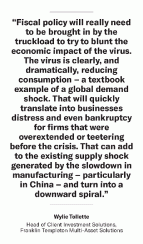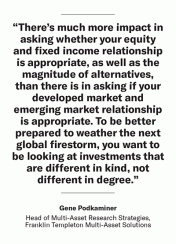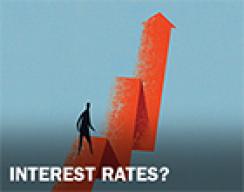The investment experts at Franklin Templeton spend a lot of time speaking to chief investment officers about “What if . . .” That is, the most beneficial discussions come from exploring the implications of what might happen – not guessing the future – and being prepared for those risks.
In the following conversation, two key players at Franklin Templeton Multi-Asset Solutions – Wylie Tollette, Head of Client Investment Solutions, and Gene Podkaminer, Head of Multi-Asset Research Strategies – talk through the “what if” of environmental shocks, such as COVID-19 (coronavirus) and other potential global pandemics.
Gene Podkaminer: So, currently this is less of a “what if” and more of a “what now” situation. Clearly, we are in the midst of a major global pandemic, experiencing the impacts and fallout in real time. For now, we've disaggregated our base case into two components. The first has to do with the coronavirus and its immediate fallout. The second has to do with the underlying fundamentals that really underpin the economy.
Let’s start with coronavirus thoughts. Our base case has moved to recession, in line with the consensus view. This was not the case earlier. However, based on new readings that we're getting in terms of fundamental impacts, market reactions, and the significant drag on economic activity globally, this is what we expect. We’re seeing that the virus continues to spread and that it could peak towards mid-year. This would lead to a sharp and significant economic slowdown.
Wylie Tollette: It’s noteworthy that in China virus growth is beginning to decelerate, and there's been a slight pickup in economic activity. This has been less so in the service sectors, however, as folks aren't out and about yet. The seasonal effect that may impact the virus could slow transmission in our base case, helping overall growth rates slow. The mortality rate is still something of an unknown as testing has not been extensive enough for us to have confidence in the statistics, but there does seem to be more of an impact on aging populations – like we’ve observed in Italy. Last, we’re seeing some efficacy with select legacy medications like antiviral drugs, so that’s a positive. There are a number of global efforts underway – akin to “wartime industry” adaptation – to develop treatments and a vaccine. When these will start to bear fruit is unclear. But when they do, we can expect to see a huge change in forward-looking views.
Podkaminer: From a policy response perspective, there's convergence around what the effective lower bounds are for interest rates and monetary policy – we've started cutting rates from a place that wasn't that high and have come all the way down to the lower bound in the U.S. Other economies, specifically in Europe, were much closer to that lower bound to begin with, and so had less room to maneuver.

The amount of freedom that central bankers have around monetary policy was a big question that was resoundingly answered in the past few weeks. The good news is we’re seeing the application of other tools, like we did in 2008, including asset purchasing programs and other liquidity measures to help funding. The next step is how policymakers transition from monetary policy to fiscal policy.
Tollette: Fiscal policy will really need to be brought in by the truckload to try to blunt the economic impact of the virus. The virus is clearly, and dramatically, reducing consumption – a textbook example of a global demand shock. That will quickly translate into businesses distress and even bankruptcy for firms that were overextended or teetering before the crisis. That can add to the existing supply shock generated by the slowdown in manufacturing – particularly in China – and turn into a downward spiral.
The good news is that fiscal stimulus is top of mind for U.S. policymakers, and they are finally working with expedience to get something sizable – around 5% of U.S. gross domestic product at last estimate – in place quickly. These plans have been targeted directly towards consumers as well as potentially providing a lifeline to certain impacted sectors – like airlines – to keep them afloat. China is rolling out fiscal stimulus, and European policymakers are starting to focus on this. They need to, and quickly.

Podkaminer: In terms of where the markets go from here, a lot of folks have been talking about which letters of the alphabet a correction may resemble. Will we see a V-shaped correction, a U-shaped correction, or an L-shaped development? In our scenarios, our base case is U-shaped; our optimistic case is V-shaped; and in our bear case, we expect an L-shape scenario with eventual recovery out in the future. We’re strongly leaning toward U-shaped, but likely with some significant ups and downs during the recovery phase. A quick V-shaped recovery seems unlikely barring an antiviral breakthrough.
We believe a U-shape recovery makes the most sense because of a projected slow initial rebound – thus, U instead of V. The delay in rebound is because the demand shock should lead to business and household stress that, in turn, leads to higher unemployment and defaults. This puts “stickier” downward pressure on aggregate demand in the recovery phase. On the positive side, our base case is that we experience the worst of the virus (in terms of peak growth rates, improved antiviral medicines, seasonal tailwinds, etc.) before the second quarter of 2020 is over.
Tollette: Maybe a U with a lazy right vertical, and it is likely to be bumpy. What's been interesting to watch, and it’s quite typical of markets, is they tend to move on sentiment in the short term, but respond to fundamentals over the medium and longer term. Valuations were extended going into this crisis – some were saying “priced for perfection,” and you tend to see very sharp reactions, either up or down, to any major sentiment change when valuations are extended.
In addition to a rational re-pricing of forward economics, the coronavirus – primarily a health issue – triggers the human fight or flight response. Some behavioral finance theories would indicate that people become more risk-averse about everything – including investments – when they're faced with a threat like the coronavirus. We think this is part of what we’re seeing in the market, and it may be a bit overdone in the short term. We are slowly starting to reposition our portfolios to take advantage of this extreme dislocation, because we think the medium- and longer-term outlook is more positive. Short term, of course, we anticipate another few months of volatility as the coronavirus crisis plays out.
Podkaminer: So, let's talk about the big picture. We’ve experienced a lot of heightened market volatility. We view this as a shock to growth and you can observe that on both the demand side and the supply side. What we've been saying – and not just us, but many other practitioners – for a long time, is that diversification is really important. I think it was Nassim Taleb who described building “anti-fragile” portfolios – and that is an attribute we consider. A lot of people are finding out now that their portfolios are brittle and fragile. So true diversification, or at least as best you can when many assets correlate as one, is always important. And it’s of paramount importance in times of extreme stress.
Tollette: And again, what we’re seeing is many folks having emotional reactions to what's going on in the markets. We would like to try to disentangle the emotional from what's going on with fundamental economic drivers of returns. And in doing so, we really want to focus on that macroeconomic backdrop. That's how we want to position our portfolios. Look past the emotional impact, look toward where we think there are long-term opportunities. And, I agree with Gene – seek diversification, even into asset classes that have been out of favor for a while. Duration may not work as well once interest rates get to zero bound. Cash is nice to have on hand, for example.
Podkaminer: Yes, and I would also add that it’s much easier to prepare for economic shocks by broadly diversifying than it is to repair a portfolio after a shock. As we’ve often discussed, we recognize that while we can’t control returns, we certainly can control risks. Just as global growth contributes to most of the return that’s coming from portfolios, it’s also an outsized contributor to risk. If I put my risk management hat on and nearly all of the risk in my portfolio is coming from global growth, I need to have a serious conversation with my stakeholders telling them, “Hey, this may have worked over the last couple of years, but I don’t necessarily expect it to work over the next five or 10. We need safety measures in a portfolio that allow us to reduce risk and potentially give up on some of that economic growth exposure so that we can be more diversified and more broadly exposed.”
Tollette: This reminds me of something we discussed a few months back during the wildfire crisis in the Western U.S. – this notion of “defensible space” in portfolios. For homeowners who built defensible space around their structures when they had the opportunity before the fires, they’re the ones whose homes typically survived. Fires emerge in capital markets, too, and we’ve seen a massive conflagration with the coronavirus pandemic, and as we get through this – which we definitely will – it will be clear who had prepared, and who learned a hard lesson.

Podkaminer: Times like this remind us of the importance of focusing on the big picture when we talk about the composition of our portfolios. Even in these uncertain times, we seek to build well-diversified, “anti-fragile” portfolios. When examining asset classes, consider them in the big picture. For example, emerging markets are a sub-asset class of equities, but they are still equities – a rose, is a rose, is a rose. The same can be said for developed market equities, private equity, and the equity component of real estate and of infrastructure investing – they are all closely related.
So, when I’m thinking about diversification in portfolios, fixed income holds a different place in the capital structure than equity does. Compared to equity, it is less impacted by growth – and growth shocks – and more impacted by interest rate policy and inflation. That’s where I think the diversification argument should really start. There’s much more impact in asking whether your equity and fixed income relationship is appropriate, as well as the magnitude of alternatives, than there is in asking if your developed market and emerging market relationship is appropriate. To be better prepared to weather the next global firestorm, you want to be looking at investments that are different in kind, not different in degree.
More in the series "What if there are shocks to ... "

Franklin Templeton
| 
Franklin Templeton
| 
FT demographics
| 
Franklin Templeton
|

Franklin Templeton
| 
FT-global growth
| 
interest rates
| 
FT
|
Disclaimers
This material is provided for informational purposes only and nothing herein constitutes investment, legal, accounting or tax advice. This material is general in nature and is not directed to any category of investors and should not be regarded as individualized, a recommendation, investment advice or a suggestion to engage in or refrain from any investment-related course of action. All information is current as of the date of this material and is subject to change without notice. Any views or opinions expressed may not reflect those of the firm or the firm as a whole. Franklin Templeton does not accept any responsibility to update any opinions or other information contained in this document. This material may include estimates, outlooks, projections and other “forward-looking statements.” Due to a variety of factors, actual events may differ significantly from those presented.
CFA® and Chartered Financial Analyst® are trademarks owned by CFA Institute.
For US Residents Only
If you would like information on Franklin Templeton’s retail mutual funds, please visit www.franklintempleton.com.
Franklin Templeton Distributors, Inc.






